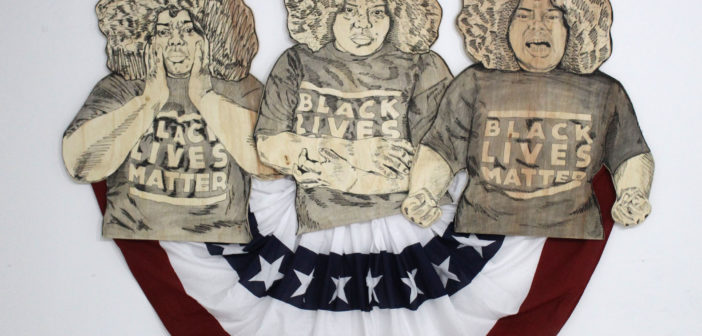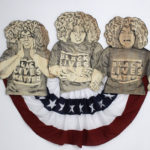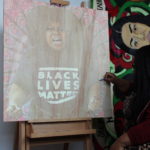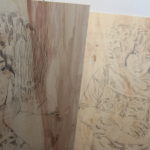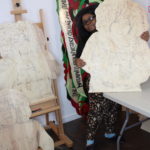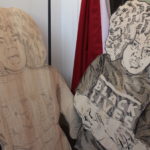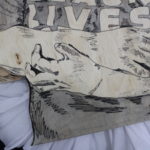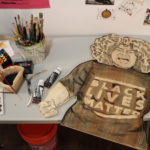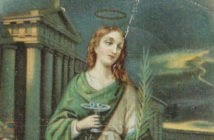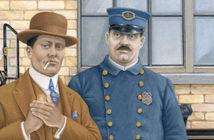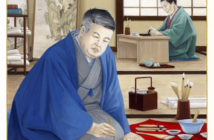Big Red & Shiny is pleased to welcome Chanel Thervil as our next Inside/Out artist in residence. Working in sculpture, painting, installation, and public art works, Thervil balances roles of visual artist, community activist, and arts educator. Her newest body of work consists of multi-media wall-based assemblages that merge the colorful, animated shapes from her purely abstract works with representational portraits of family members, friends, and acquaintances. These dynamic pieces capture the essence of the individuals portrayed and emit a sense of resilience and hope. Thervil earned a BFA in Painting at Pace University, New York, and an MA in Art Education at Massachusetts College of Art and Design, Boston. In addition to her studio practice, she works at community-focused arts organizations such as sparc! the ArtMobile and The Art Connection. During her residency at BR&S, Thervil will reflect on the current social and political climate as it relates to her artistic process. —Scout Hutchinson, Editorial Assistant
“A book, or a work of art [culture]cannot by itself change the world, but by asking the questions that matter, it might attempt to be an act of articulation against violence, both the brutal and casual kinds. It might aspire to starting a conversation, through which together we might find common meaning and words that free.”
-Jeff Chang
For this digital artist residency with Big Red & Shiny I will produce a series of essays that explore different emotions I’ve been processing and trying to articulate visually in America’s Post-Obama Era. This week the topic at hand is Pain:
I will never forget the sensation of numbness caused by disappointment following the 2016 election results. As I awaited the news that there had been some sort of mistake, I nodded my head in agreement with Van Jones sentiments of not knowing what to tell his children in the morning. Luckily, I don’t have children. But I am a black woman, a descendant of immigrants, and an artist who happens to work in the non-profit sector, so there was cause for concern.
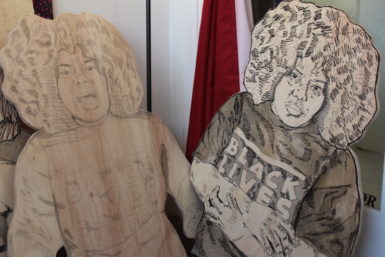
"Here you can see the difference pre- and post-ink and acrylic." Image courtesy the artist.
Eventually morning did come, but not without consequence. Record high suicide hotline calls, deeper immersion into a rapid fire of social media alerts, and ongoing conversations about what to do now was the first wave of our country’s new normal. Internally, my hyper-sensitivity about all of the ways I was an “other” went into overdrive as I tried to navigate conversations in predominantly white spaces that housed an abundance of white guilt cocktails with a side of “How could this happen?” I didn’t have the answers. I didn’t have anything to add that would bring solace to my white counterparts, nor was I interested in being unwillingly assigned the role of their soother because I happened to be the nearest person of color in their orbit. Simultaneously, I was so perplexed by the people of color close to me who willingly voted for Trump, or not at all. I couldn’t even begin to unpack the conglomerate rock of reasons why I wanted them to have chosen differently.
So I opted not to speak, siding with thoughts of Kara Holloway: “The reality of racism and sexism means that we must configure our private realities to include an awareness of what our public image might mean to others.This is not paranoia. It is preparedness.” In general, I often feel like my thoughts move so quickly that my body is always struggling to catch up. The last thing I wanted to do was to be misunderstood because I chose the wrong words with the wrong person at the wrong time. But this level of self-policing took its toll in the form of resentment, irritability, and sleepless nights. As Solange’s lyrics suggest, being weary of the ways of the world is as exhausting as it is stifling. Since words couldn’t be my outlet, art took it’s place. As soon as I acquired a studio space, my first venture into the rejuvenation of my personal practice was a mixed-media self-portrait titled Pity Party: Selfies for the Trump Era.
To create this work, I began by photographing myself, freely letting my body display all of my pent up emotions. What came to the surface were three images that reflected my responses to varying degrees of empathy from my country, peers, and partner at the time. It was a beyond-liberating experience to scream, make-up free in my studio and see unfiltered versions of my emotions captured in an image.

"Captured myself mid-scream in my studio thanks to my handy dandy timer and tripod." Image courtesy the artist.
Next came some material choices. Wood is my favorite base material to work with. The smell of sawdust and the buzz of power tools always brings back memories of my high school days doing theater tech. I’m wedded to the idea that stage sets are the base for cultivating new narratives; just as essential as the actors. Since these works are a literal manifestation of my voice, I chose to make them slightly larger than life-size, much like the personas of actors who are great at their craft.
In addition to my admiration for Whitfield Lovell, Gustav Klimt, Kehinde Wiley and Swoon, my childhood and teen years spent drooling over the graphic novel section of the library have made me sensitive to mark making and gesture within drawings. The sketchy nature of my linework relates to the instability of my representation within American society, no matter how much I indulge in respectability politics. This is echoed by my Black Lives Matter t-shirt to amplify the fact that my blackness is visible, while simultaneously being denied humanity like many of the victims whose deaths inspired the hashtag.
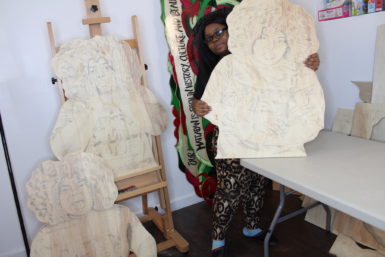
"Proof that each figure is slightly larger than the real thing. I used a jigsaw to liberate each figure from the squares they started in." Image courtesy the artist.
And last but not least came the addition of the pleated flag. My time working in galleries and museums has taught me that people aren’t naturally inclined to read the label to learn the title of an artwork. I wanted to ensure that there was a recognizable connection made between the emotions expressed in the figures and America even if the viewer couldn’t pause for too long to take it in. The few times in my life I’ve encountered pleated flags were in textbook images of plantations, when visiting neighborhoods primarily filled with veterans, or as casual adornments during election seasons in the spirit of patriotism.
My relationship with patriotism has been a complicated cycle of active participant and skeptical bystander because of America’s love-hate relationship with blackness and my internal struggles with my lineage as a Haitian-American woman. The juxtaposition of my likeness on top of the half circle of America aligns with Audre Lorde’s observations: “Within this country where racial difference creates a constant, if unspoken, distortion of vision, Black women have on the one hand always been highly visible, and so, on the other hand, have been rendered invisible through the depersonalization of racism….That visibility [blackness]which makes us most vulnerable is also the source of our greatest strength.”

"Detail of an embrace within the figure." Image courtesy the artist.
In putting myself out there both with this work and with this article, I have found myself grappling with the following questions left unanswered:
Is it possible to voice pain without vulnerability?
When does vulnerability become exploitative?
Where should the line be drawn?
And is there a way to measure vulnerability’s strength?
You can view “Pity Party: Selfies for the Trump Era” in person as a part of the group exhibition “Sting! XXV: Thrive” on view at The Beehive from now to October 18th.
Works Cited
Jeff Chang, Who We Be: A Cultural History of Race in Post-Civil Rights America, p.12
Van Jones, "How do I explain this to my children?", CNN video
Patricia Hill Collins, Black Feminist Thought: Knowledge, Consciousness, and the Politics of Empowerment, p.100
Solange: Weary (Lyrics Unpacked), GENIUS
"About the Black Lives Matter Network"
Audre Lorde, The Transformation of Silence Into Language and Action, p.42
- Chanel Thervil, “Pity Party: Selfies at the Start of the Trump Era,” 2017, acrylic on wood with pleated flag, 61 x 74 inches, Image courtesy the artist.
- “Captured myself mid-scream in my studio thanks to my handy dandy timer and tripod.” Image courtesy the artist.
- “Once I have the images projected on to the wood it’s time to sketch.” Image courtesy the artist.
- “Here are some peeks at the other two figures.” Image courtesy the artist.
- “Proof that each figure is slightly larger than the real thing. I used a jigsaw to liberate each figure from the squares they started in.” Image courtesy the artist.
- “Here you can see the difference pre- and post-ink and acrylic.” Image courtesy the artist.
- “Detail of an embrace within the figure.” Image courtesy the artist.
- “In addition to ink and acrylic paint, I also used a variety of markers for some of the line work.” Image courtesy the artist.

